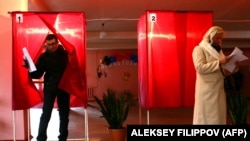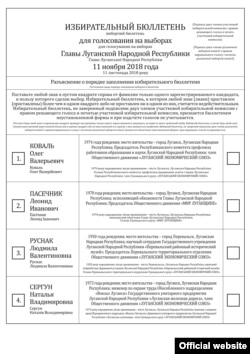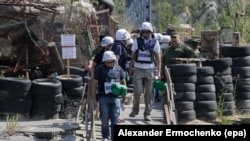On November 12, journalists, advocates and Ukrainians reacted to a reprint of an Associated Press (AP) news story and this Washington Post headline: “Separatists win vote in Ukraine rebel regions by big margins.”
Their complaint: the headline and lead in the story implied that non-separatist candidates ran in Donetsk and Luhansk “elections” on November 11, lending legitimacy to a “separatist” militancy that was a Russian creation.
“You are misleading your readers w these absolutely inaccurate terms,” said Kateryna Kruk on Twitter. Kruk is a Ukrainian journalist, activist and a fellow at Kremlin Watch, a Prague-based organization that monitors “disinformation stories” and recommends policy responses as a consultant for the Czech Interior Ministry.
While the Washington Post website was cited by some of the advocates on social media, the article was written by the Associated Press. Polygraph.info contacted the Washington Post foreign desk seeking comment.
“AP and other autofeed copy go directly into the Post online system. For print, wire stories may be edited for length,” Shani George, communications director of the Washington Post, wrote in a short statement.
Polygraph.info also contacted the AP, which sent a statement on the matter.
“Our story made clear from the first paragraph on down that the legitimacy of these elections was in question,” the statement from AP news deputy news director for Europe Niko Price read.
It continued: “There is also no question that the candidates were separatists: While there is significant internal debate among the factions within Donbass(sic) about whether the final goal should be unification with Russia or establishment of the DNR and LNR as nominally sovereign states, both sides agree they want to separate from Ukraine. We stand by our story.”
The AP story did point out in the lead sentence that the vote was “denounced…as illegitimate” and later in the story referred to a statement by the German and French leaders Merkel and Macron referring to “so-called” elections.
The AP story, however:
- Did not appear to include any AP reporting from Ukraine or the Donetsk and Luhansk regions.
- Described “Russian-backed separatists,” but also referenced them as“rebel leaders” in quoting misleading arguments about the Minsk II agreement.
- Referenced the 2015 Minsk agreement, while providing no context.
- Quoted a Kremlin official and the leaders of Donetsk and Luhansk, without further context on the accuracy of their statements.
- Included no details on alternative candidates or the makeup of the electorate.
Let’s take the last point: In our search online for the official ballots for the November 11 election, Polygraph.info found evidence indicating an absence of non-“separatist” candidates in the documents of the “Central Election Committees” of the two pro-Russian regions. The documents are accessible on the websites of both “DNR” and “LNR.”
For instance, the “DNR” election committee has only published a generic sample of the ballot with the “John Doe” (Ivan Ivanov, Petr Petrov) names on it, while the actual ballot with the names and affiliations of the real candidates was not published. The reporting of the results released by the “DNR” election committee confirmed that no candidate opposing the separation of the region from Ukraine was put before the voters.
In the “LNR,” the election committee published the actual ballot, which demonstrated unusual qualities. For instance, apart from the front-runner and the eventual winner of the “election,” the three listed candidates represented the same social movement -- the “Lugansk Economic Union” – a group created in 2014 after Russia’s annexation of Crimea, according to Australia’s exhaustively sourced sanctions regime.
The group’s own political platform advocates “integration of LNR into the economic space of the Russian Federation and one of its leaders can be see on on Russian social media, vKontakte, as congratulating “all real men” on the Day of Russian Army.
And so in Luhansk there were no candidates espousing non-“separatist” voters.
Both the DNR sample ballot and the LNR ballots were in the Russian language, not Ukrainian.
On the Minsk II agreement: The AP story misrepresents the agreement, signed in 2015, referring to “a 2015 peace deal (that) called for local elections in Donetsk and Luhansk.”
The inference is that the “separatists” were merely holding elections as part of the agreement.
In reality, the Minsk II agreement does not make any reference to a Donetsk or Luhansk People’s Republic. Instead, the locations are referred to as “certain areas of the Donetsk and Luhansk Region.” More importantly, point nine of the agreement states that local elections must be held “on the basis of the Law of Ukraine and constitutional reform.” In a later reference to local elections, point 12 of the agreement stipulates that, “elections will be held in accordance with relevant OSCE (Organization for Security and Co-operation in Europe) standards and monitored by OSCE/ODIHR.” None of the conditions laid out in the agreement were met in the November 11 polling.
The U.S. State Department refers to the Crimea section of Ukraine as occupied, and the DNR and LNR republics as under “forcible control” of Russia.
The story includes direct quotes from Russian presidential press secretary Dmitry Peskov as well as some of the “rebel” leaders in Russian-occupied Donbas, but no Ukrainians, rendering AP assurances of balance in the article to be null.
Peskov’s claim that the “separatist” regions “were fighting for survival as a result of a Ukrainian blockade and a looming threat of the resumption of full-scale fighting” is misleading. The economic blockade from Ukraine is a fact. But so are nearly daily military operations, making that border into Ukraine-governed territory a conflict zone, initiated by Russia. Donetsk and Luhansk “survive only due to Russian assistance,” Stephen Pfier of the Brookings Institution wrote in October. Meanwhile, reports indicate that Russian military men and materiel, as well as “humanitarian” convoys, continue cross into the regions from Russia. OSCE monitors are blocked from inspecting the inflow.
“Decent media should prohibit their biased & intimidated Moscow correspondent to report on Ukraine,” Atlantic Council fellow Anders Aslund posted on Twitter. “They are both too ignorant & too full of Kremlin propaganda.”
Aslund’s post came amid complaints over the AP story, datelined Moscow, though he did not respond to a question about whether he was referring to the Moscow-based wire service report.
The AP article mentions neither the fact that these elections were not monitored by any qualified election observers, nor the OSCE Special Monitoring Mission's observations about armed men in the vicinity of polling places and citizens complaining of feeling “compelled” to vote.
Finally, after the “elections,” the leader of the self-proclaimed “Donetsk People’s Republic” Denis Pushilin, announced that he would seek closer integration with Moscow. In his address, he accused Kyiv of “abandoning” the breakaway regions. This is an unusual characterization from a supposed “separatist” leader, given that by definition separatists seek to leave or “abandon” an established country.
While a daily election story by a wire service is unlikely to contain the detail in this fact check, the tenor of the article should reflect reality. Accordingly, we find the AP story and the headline on the Washington Post online feed to be misleading.
Further Context
Another relevant fact is a poll reported by the independent Ukrainian media outlet Hromadske, which found that residents of the occupied areas increasingly favor reintegration into Ukraine.
“In the separatist-controlled areas of the Donetsk region, 63% of surveyed in 2018 said they favor the idea of reintegrating Donbas into Ukraine, given the decentralization reform takes place,” the report stated. “This is a four percent increase from 2016 when 59% supported or agreed with the idea. While the number of respondents who considered this option ‘unacceptable in any case’ reduced from 37% in 2016 to 28% in 2018.”
The report stated that support for reintegration in the Luhansk region, had not changed from 2016 to 2018, but that it remains at 63%.
If accurate, this polling data indicate that a clear majority of residents in these areas favor reintegration with the rest of Ukraine. Yet, in spite of this, “separatists” won the elections, and “by big margins,” according to the AP headline.The OSCE Special Monitoring Mission, in an election day spot report, said some citizens reported feeling “compelled to vote” or lose access to salaries and healthcare.
A study by the University of Oxford in 2015, just after Russia launched its covert operation in Ukraine, found “little support” for separatism or desire to join Russia. According to the study, fewer than 5% of respondents favored solutions “that would lead to the breakup of the country.” Ostrov, a Donetsk-based publication, held its own survey in July of 2014 as the war began. It found that 75% of respondents saw their future as being in Ukraine. Only three percent saw their future in the self-proclaimed “Donetsk People’s Republic.” However, questions remain as to how representative the survey was.








